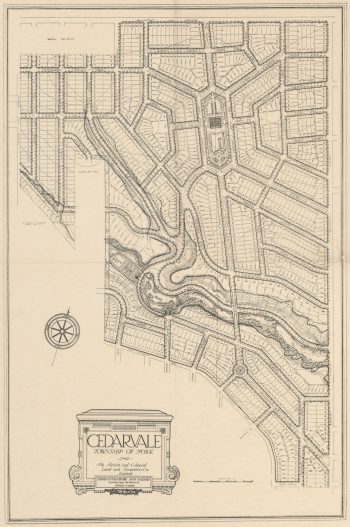
Architecture is a group effort, involving the participation of many creative collaborators along the way. During design and construction, numerous contractors and sub-contractors are involved, and the records of the architectural firms in the Archives’ holdings include evidence of their participation in every aspect, from foundations to fixtures.
The records highlighted here are representative of additional archival collections that illustrate the important role played in the architectural endeavour by other professions and trades, in this case landscape architects and metal fabricators.
Howard B. Grubb and Lorrie A. Dunington established a landscape architecture practice in Toronto as Dunington-Grubb. Although much of their practice involved private residential gardens, they were also involved in public projects, including the gardens along Toronto’s University Avenue.
Their practice coincided with the City Beautification movement of the early 20th century, and in that vein, they produced designs for garden suburbs, one of which is shown here.

In 1914, Dunington-Grubb established the nursery that became Sheridan Nurseries. They were also involved in the founding of the Canadian Society of Landscape Architects in 1934 and the in establishment of a landscape architecture program at the University of Toronto.
For a brief period from about 1925 to 1955, Bayview Avenue was a pastoral suburb located at the edge of the city. Sprawling country houses were built nestled into the picturesque setting, with the carefully landscaped grounds gradually giving way to the raw, natural beauty of the adjacent Don Valley.
Scenes from this lost era are shown on lantern slides taken by William M. Crisp, Landscape Gardener. His son Grenville, was also the chief gardener for Glendon Hall, the home of E.R. Wood, at Bayview and Lawrence avenues. The property has been owned by the University of Toronto since the 1950s.
Emile Wenger was a Swiss German metalworker who immigrated to Canada in the 1920s. From 1926 until his death in the 1970s, Wenger worked in a small shop and forge located in a former livery in an alley southwest of Ossington Ave. and Bloor Street W.
Wenger’s work exhibits his skill in traditional iron forged technique and in working with modern materials such as aluminum. He produced a wide assortment of objects including: candlesticks, lanterns and lamps; fences and gates; fireplace grates and accessories; stair railings and newel posts; and a variety of hinges, doorknobs and other hardware.
His work, executed both in revival and modern styles, can still be found at residences in Rosedale and Forest Hill and in local churches and commercial buildings.
Perhaps Wenger’s most significant works were the now lost grilles and doors that he created in 1929 for the Concourse Building, still located on Adelaide St. W., a project of the Baldwin & Greene architectural firm.
Wenger worked for a number of other architectural firms, including John Lyle, Sproatt & Rolph, Allward & Gouinlock, Murray Brown and George Moorehouse, and for the landscape architects Dunnington-Grubb. As well, Aikenhead’s Hardware was a major client, for whom Wenger produced a wide variety of custom ironwork over the years.
Back to: introduction